Effects of Nitrogen on Microstructure and Properties of SDSS 2507 Weld Joints by Gas Focusing Plasma Arc Welding
Abstract
1. Introduction
2. Materials and Experimental Procedure
3. Results and Discussion
3.1. Effect of Nitrogen on Microstructure and Element Distribution
3.2. Effect of Nitrogen on Microhardness
4. Conclusions
- The addition of nitrogen increased the content of austenite in the WM from 22.2% to 40.2%. The optimal phase ratio can obtain SDSS 2507 welded joints with good quality and mechanical property. Thin grain boundary austenite and small intragranular austenite exist in the weld without nitrogen addition, while a large amount of coarse, side-plate Widmanstätten austenite appears in the weld with nitrogen addition.
- The growth of ferrite in the WM exhibited a preferred orientation direction, while the orientation direction of the austenite phase was disordered. The max texture intensity of ferrite decreased when nitrogen was added.
- The addition of nitrogen increased the microhardness of the austenite in the WM due to the solid solution strengthening of nitrogen and more dislocation tangle while it decreased the microhardness of ferrite.
- The nitrogen, as the focusing gas, plays an important role in increasing the content of austenite. The influence of the nitrogen flow rate on the microstructure, mechanical property and corrosion resistance should be studied in gas focusing plasma arc welding of SDSS 2507.
Author Contributions
Funding
Institutional Review Board Statement
Informed Consent Statement
Data Availability Statement
Conflicts of Interest
References
- George, P.; Wins, K.L.D.; Dhas, D.E.J.; George, P. Machinability, weldability and surface treatment studies of SDSS 2507 material-A review. Mater. Today Proc. 2021, 46, 7682–7687. [Google Scholar] [CrossRef]
- Hosseini, V.A.; Hurtig, K.; Eyzop, D.; Östberg, A.; Janiak, P.; Karlsson, L. Ferrite content measurement in super duplex stainless steel welds. Weld. World 2018, 63, 551–563. [Google Scholar] [CrossRef]
- Guo, L.Q.; Bai, Y.; Xu, B.Z.; Pan, W.; Li, J.X.; Qiao, L.J. Effect of hydrogen on pitting susceptibility of 2507 duplex stainless steel. Corros. Sci. 2013, 70, 140–144. [Google Scholar] [CrossRef]
- Varbai, B.; Pickle, T.; Májlinger, K. Effect of heat input and role of nitrogen on the phase evolution of 2205 duplex stainless steel weldment. Int. J. Press. Vessel. Pip. 2019, 176, 103952. [Google Scholar] [CrossRef]
- Hosseini, V.A.; Wessman, S.; Hurtig, K.; Karlsson, L. Nitrogen loss and effects on microstructure in multipass TIG welding of a super duplex stainless steel. Mater. Des. 2016, 98, 88–97. [Google Scholar] [CrossRef]
- Holländer Pettersson, N.; Lindell, D.; Lindberg, F.; Borgenstam, A. Formation of Chromium Nitride and Intragranular Austenite in a Super Duplex Stainless Steel. Metall. Mater. Trans. A 2019, 50, 5594–5601. [Google Scholar] [CrossRef]
- Hosseini, V.A.; Hurtig, K.; Karlsson, L. Effect of multipass TIG welding on the corrosion resistance and microstructure of a super duplex stainless steel. Mater. Corros. 2017, 68, 405–415. [Google Scholar] [CrossRef]
- Paulraj, P.; Garg, R. Effect of Intermetallic Phases on Corrosion Behavior and Mechanical Properties of Duplex Stainless Steel and Super-Duplex Stainless Steel. Adv. Sci. Technol. Res. J. 2015, 9, 87–105. [Google Scholar] [CrossRef]
- Han, Y.; Zou, D.N.; Zhang, W.; Yu, J.H.; Qiao, Y.Y. Influence of Sigma Phase Precipitation on Pitting Corrosion of 2507 Super-Duplex Stainless Steel. Mater. Sci. Forum 2010, 658, 380–383. [Google Scholar] [CrossRef]
- Gupta, A.; Kumar, A.; Baskaran, T.; Arya, S.B.; Khatirkar, R.K. Effect of Heat Input on Microstructure and Corrosion Behavior of Duplex Stainless Steel Shielded Metal Arc Welds. Trans. Indian Inst. Met. 2018, 71, 1595–1606. [Google Scholar] [CrossRef]
- Kim, S.-T.; Jang, S.-H.; Lee, I.-S.; Park, Y.-S. Effects of solution heat-treatment and nitrogen in shielding gas on the resistance to pitting corrosion of hyper duplex stainless steel welds. Corros. Sci. 2011, 53, 1939–1947. [Google Scholar] [CrossRef]
- Zhang, Z.; Jing, H.; Xu, L.; Han, Y.; Zhao, L. Investigation on microstructure evolution and properties of duplex stainless steel joint multi-pass welded by using different methods. Mater. Des. 2016, 109, 670–685. [Google Scholar] [CrossRef]
- Chehuan, T.; Dreilich, V.; de Assis, K.S.; de Sousa, F.V.V.; Mattos, O.R. Influence of multipass pulsed gas metal arc welding on corrosion behaviour of a duplex stainless steel. Corros. Sci. 2014, 86, 268–274. [Google Scholar] [CrossRef]
- Mourad, A.H.I.; Khourshid, A.; Sharef, T. Gas tungsten arc and laser beam welding processes effects on duplex stainless steel 2205 properties. Mater. Sci. Eng. A 2012, 549, 105–113. [Google Scholar] [CrossRef]
- Taban, E. Toughness and microstructural analysis of superduplex stainless steel joined by plasma arc welding. J. Mater. Sci. 2008, 43, 4309–4315. [Google Scholar] [CrossRef]
- Lai, R.; Cai, Y.; Wu, Y.; Li, F.; Hua, X. Influence of absorbed nitrogen on microstructure and corrosion resistance of 2205 duplex stainless steel joint processed by fiber laser welding. J. Mater. Process. Technol. 2016, 231, 397–405. [Google Scholar] [CrossRef]
- Muthupandi, V.; Bala Srinivasan, P.; Shankar, V.; Seshadri, S.K.; Sundaresan, S. Effect of nickel and nitrogen addition on the microstructure and mechanical properties of power beam processed duplex stainless steel (UNS 31803) weld metals. Mater. Lett. 2005, 59, 2305–2309. [Google Scholar] [CrossRef]
- Zhang, Z.; Jing, H.; Xu, L.; Han, Y.; Zhao, L.; Lv, X.; Zhang, J. Influence of heat input in electron beam process on microstructure and properties of duplex stainless steel welded interface. Appl. Surf. Sci. 2018, 435, 352–366. [Google Scholar] [CrossRef]
- Migiakis, K.; Papadimitriou, G.D. Effect of nitrogen and nickel on the microstructure and mechanical properties of plasma welded UNS S32760 super-duplex stainless steels. J. Mater. Sci. 2009, 44, 6372–6383. [Google Scholar] [CrossRef]
- Muthupandi, V.; Bala Srinivasan, P.; Seshadri, S.K.; Sundaresan, S. Effect of weld metal chemistry and heat input on the structure and properties of duplex stainless steel welds. Mater. Sci. Eng. A 2003, 358, 9–16. [Google Scholar] [CrossRef]
- Qing Li, T.; Yang, X.M.; Chen, L.; Zhang, Y.; Cheng Lei, Y.; Chun Yan, J. Arc behaviour and weld formation in gas focusing plasma arc welding. Sci. Technol. Weld. Join. 2019, 25, 329–335. [Google Scholar] [CrossRef]
- Westin, E.M.; Hertzman, S. Element distribution in lean duplex stainless steel welds. Weld. World 2014, 58, 143–160. [Google Scholar] [CrossRef]
- Kim, H.-J.; Jeon, S.-H.; Kim, S.-T.; Lee, I.-S.; Park, Y.-S.; Kim, K.-T.; Kim, Y.-S. Investigation of the sensitization and intergranular corrosion of tube-to-tubesheet welds of hyper duplex stainless steel using an electrochemical reactivation method. Corros. Sci. 2014, 87, 60–70. [Google Scholar] [CrossRef]
- Zhang, Z.; Jing, H.; Xu, L.; Han, Y.; Zhao, L.; Zhang, J. Influence of microstructure and elemental partitioning on pitting corrosion resistance of duplex stainless steel welding joints. Appl. Surf. Sci. 2017, 394, 297–314. [Google Scholar] [CrossRef]
- Ha, H.-Y.; Jang, M.-H.; Lee, T.-H.; Moon, J. Understanding the relation between phase fraction and pitting corrosion resistance of UNS S32750 stainless steel. Mater. Charact. 2015, 106, 338–345. [Google Scholar] [CrossRef]
- Ha, H.-Y.; Jang, M.-H.; Lee, T.-H.; Moon, J. Interpretation of the relation between ferrite fraction and pitting corrosion resistance of commercial 2205 duplex stainless steel. Corros. Sci. 2014, 89, 154–162. [Google Scholar] [CrossRef]
- Jiang, Y.; Tan, H.; Wang, Z.; Hong, J.; Jiang, L.; Li, J. Influence of Creq/Nieq on pitting corrosion resistance and mechanical properties of UNS S32304 duplex stainless steel welded joints. Corros. Sci. 2013, 70, 252–259. [Google Scholar] [CrossRef]
- Silva, R.; Kugelmeier, C.; Vacchi, G.; Martins, C.; Dainezi, I.; Afonso, C.; Filho, A.M.; Rovere, C. A comprehensive study of the pitting corrosion mechanism of lean duplex stainless steel grade 2404 aged at 475 °C. Corros. Sci. 2021, 191, 109738. [Google Scholar] [CrossRef]
- Kang, D.H.; Lee, H.W. Study of the correlation between pitting corrosion and the component ratio of the dual phase in duplex stainless steel welds. Corros. Sci. 2013, 74, 396–407. [Google Scholar] [CrossRef]
- Erazmus-Vignal, P.; Vignal, V.; Saedlou, S.; Krajcarz, F. Corrosion behaviour of sites containing (Cr, Fe)2N particles in thermally aged duplex stainless steel studied using capillary techniques, atomic force microscopy and potentiostatic pulse testing method. Corros. Sci. 2015, 99, 194–204. [Google Scholar] [CrossRef]
- Guo, E.-Y.; Xie, H.-X.; Singh, S.S.; Kirubanandham, A.; Jing, T.; Chawla, N. Mechanical characterization of microconstituents in a cast duplex stainless steel by micropillar compression. Mater. Sci. Eng. A 2014, 598, 98–105. [Google Scholar] [CrossRef]
- Zhang, Z.; Zhang, H.; Hu, J.; Qi, X.; Bian, Y.; Shen, A.; Xu, P.; Zhao, Y. Microstructure evolution and mechanical properties of briefly heat-treated SAF 2507 super duplex stainless steel welds. Constr. Build. Mater. 2018, 168, 338–345. [Google Scholar] [CrossRef]
- Saravanan, S.; Raghukandan, K.; Sivagurumanikandan, N. Pulsed Nd: YAG laser welding and subsequent post-weld heat treatment on super duplex stainless steel. J. Manuf. Process. 2017, 25, 284–289. [Google Scholar] [CrossRef]
- Zhang, Z.; Jing, H.; Xu, L.; Han, Y.; Zhao, L.; Zhou, C. Effects of nitrogen in shielding gas on microstructure evolution and localized corrosion behavior of duplex stainless steel welding joint. Appl. Surf. Sci. 2017, 404, 110–128. [Google Scholar] [CrossRef]
- Zhang, Z.; Jing, H.; Xu, L.; Han, Y.; Gao, Z.; Zhao, L.; Zhang, J. Microstructural characterization and electron backscatter diffraction analysis across the welded interface of duplex stainless steel. Appl. Surf. Sci. 2017, 413, 327–343. [Google Scholar] [CrossRef]
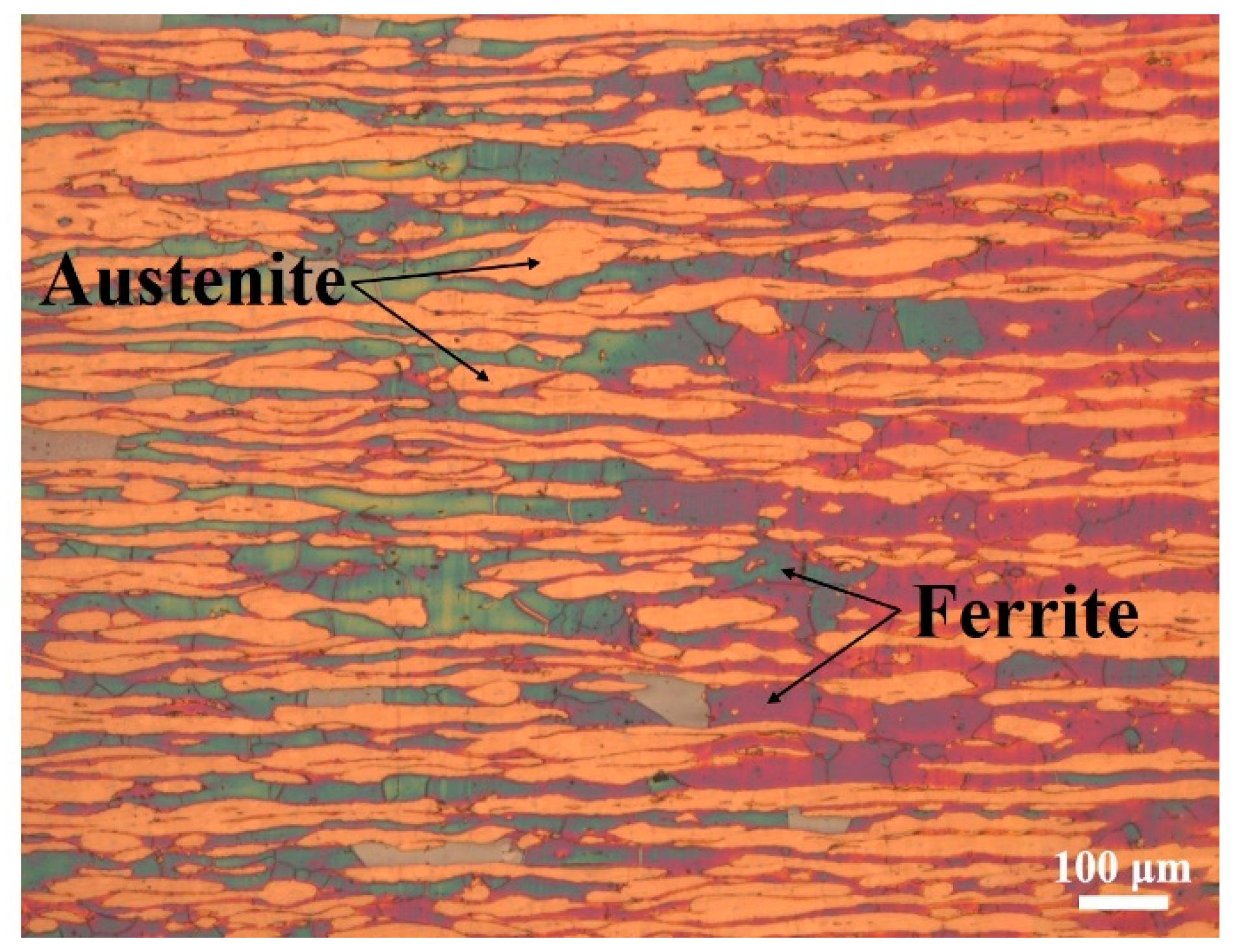
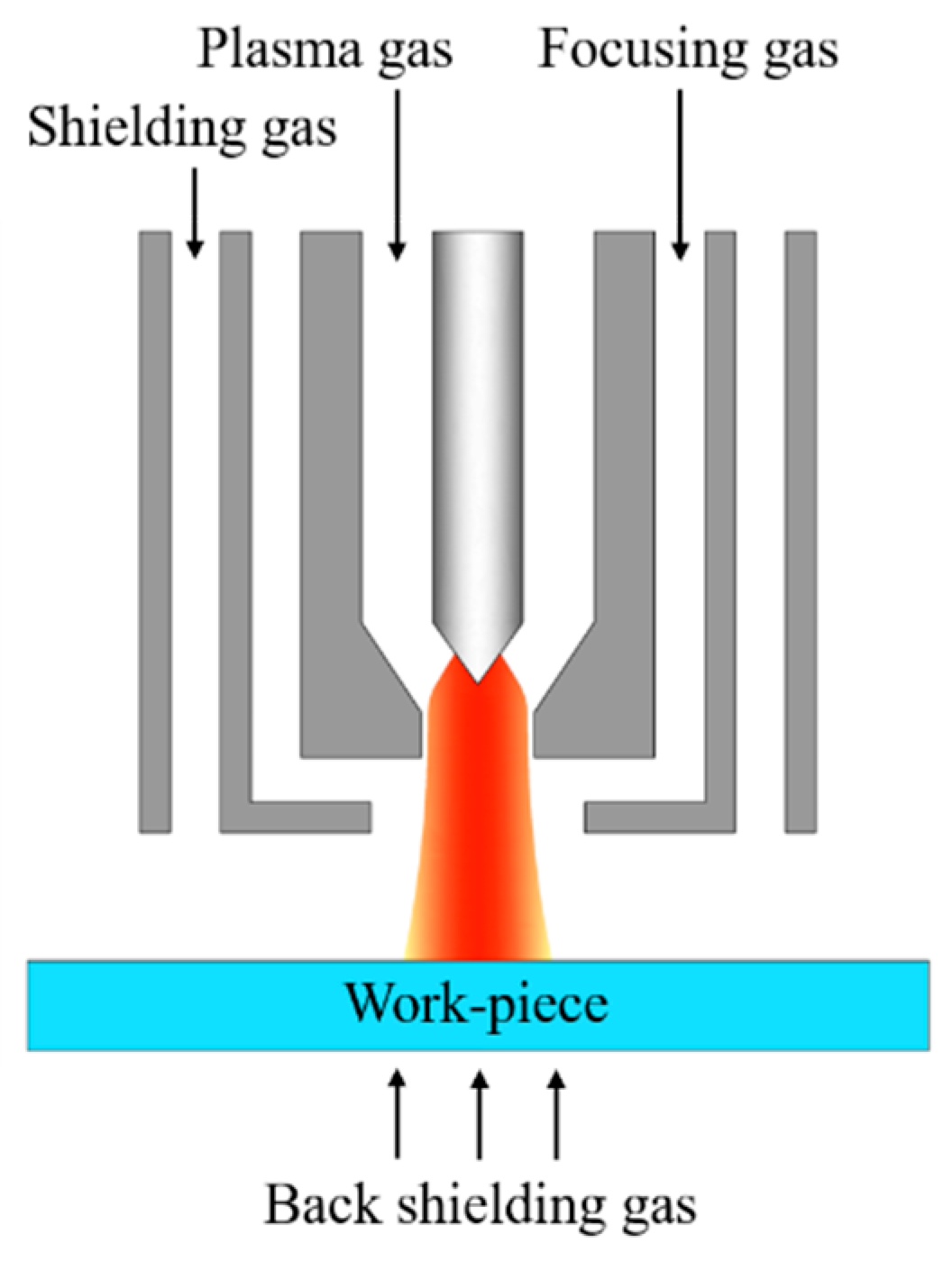
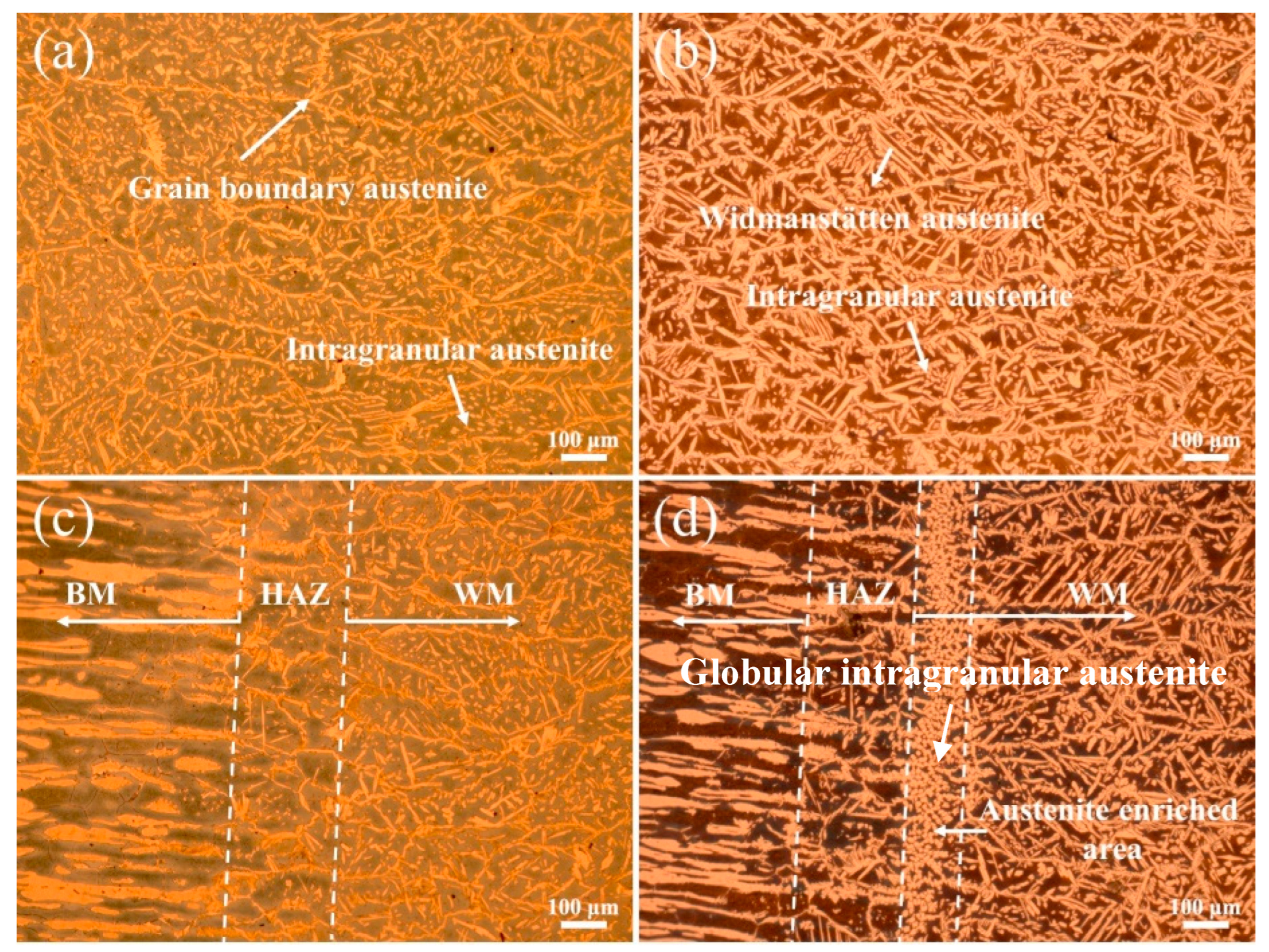
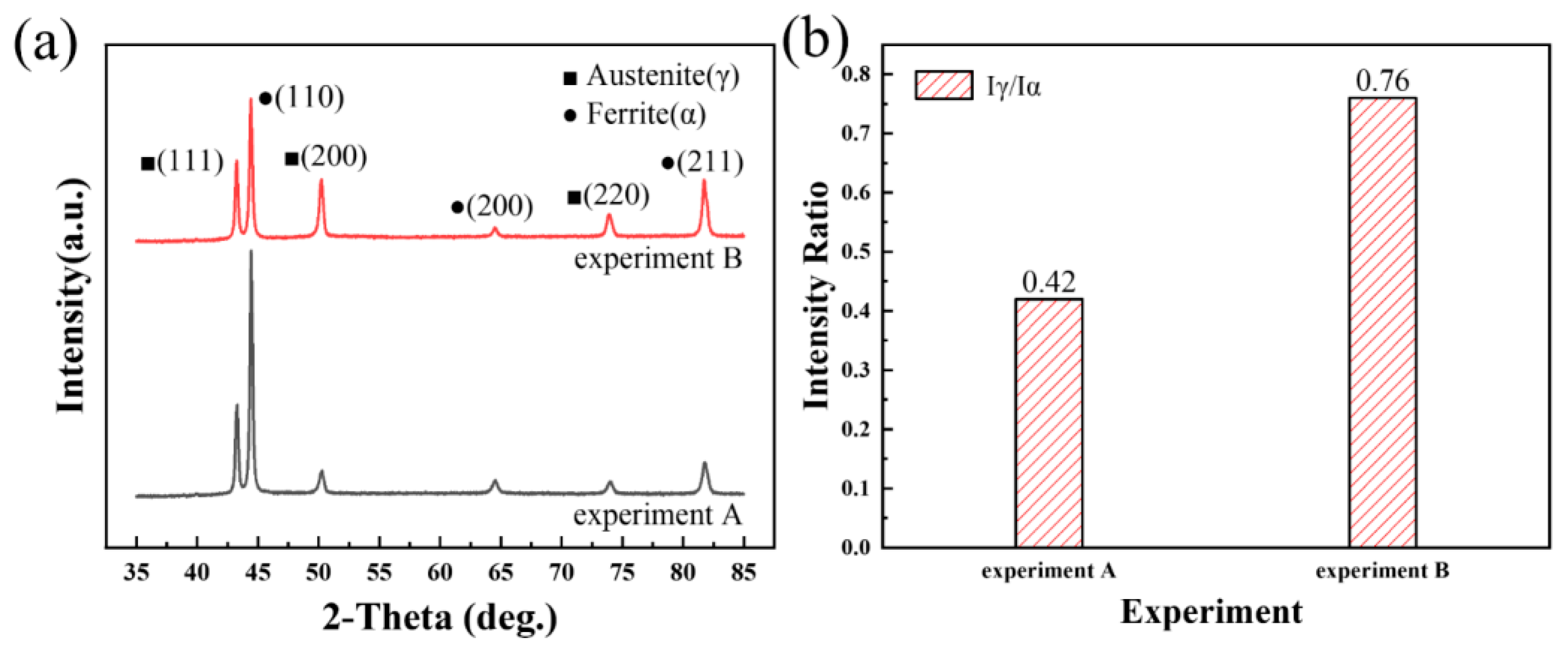
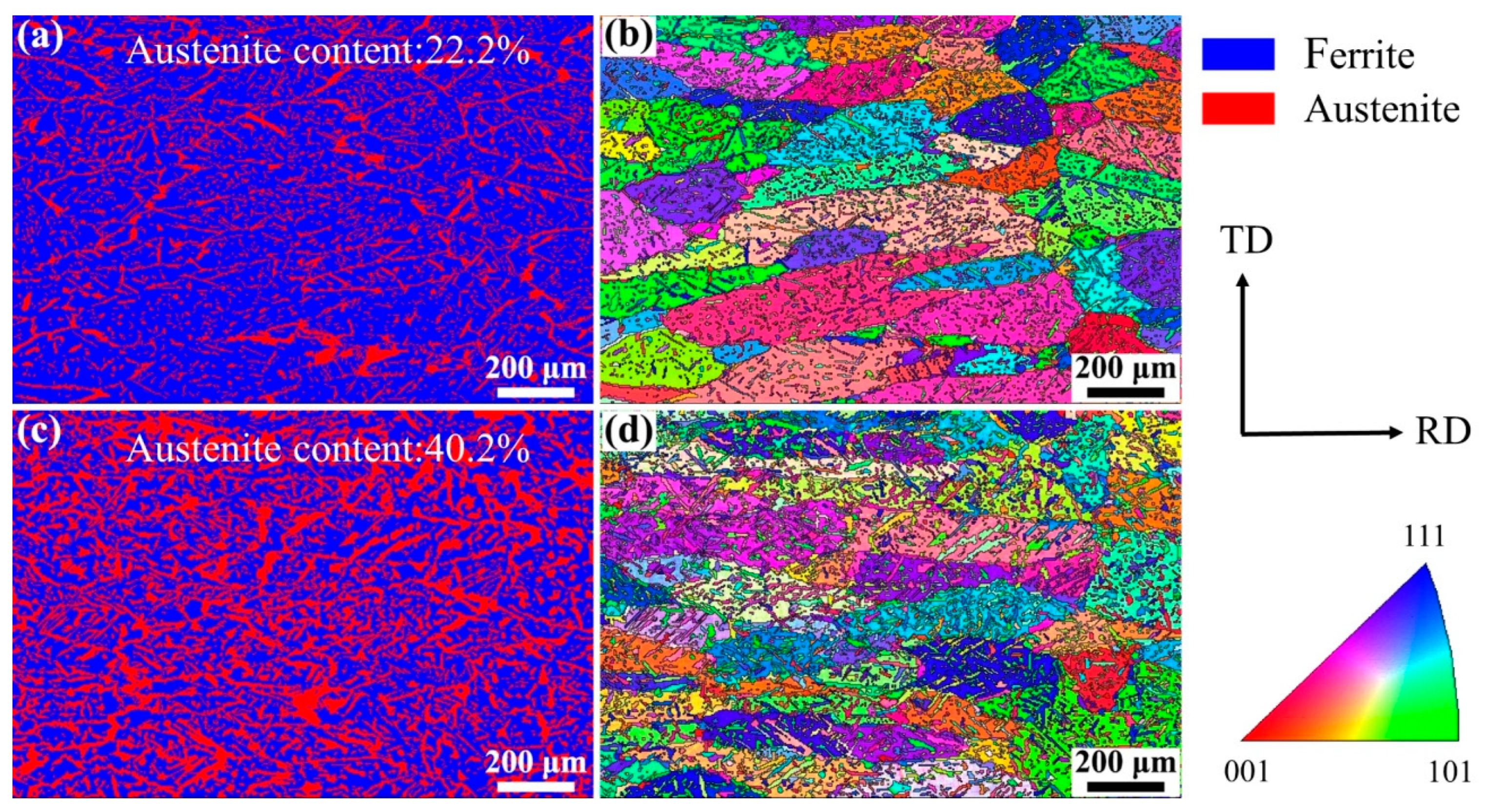
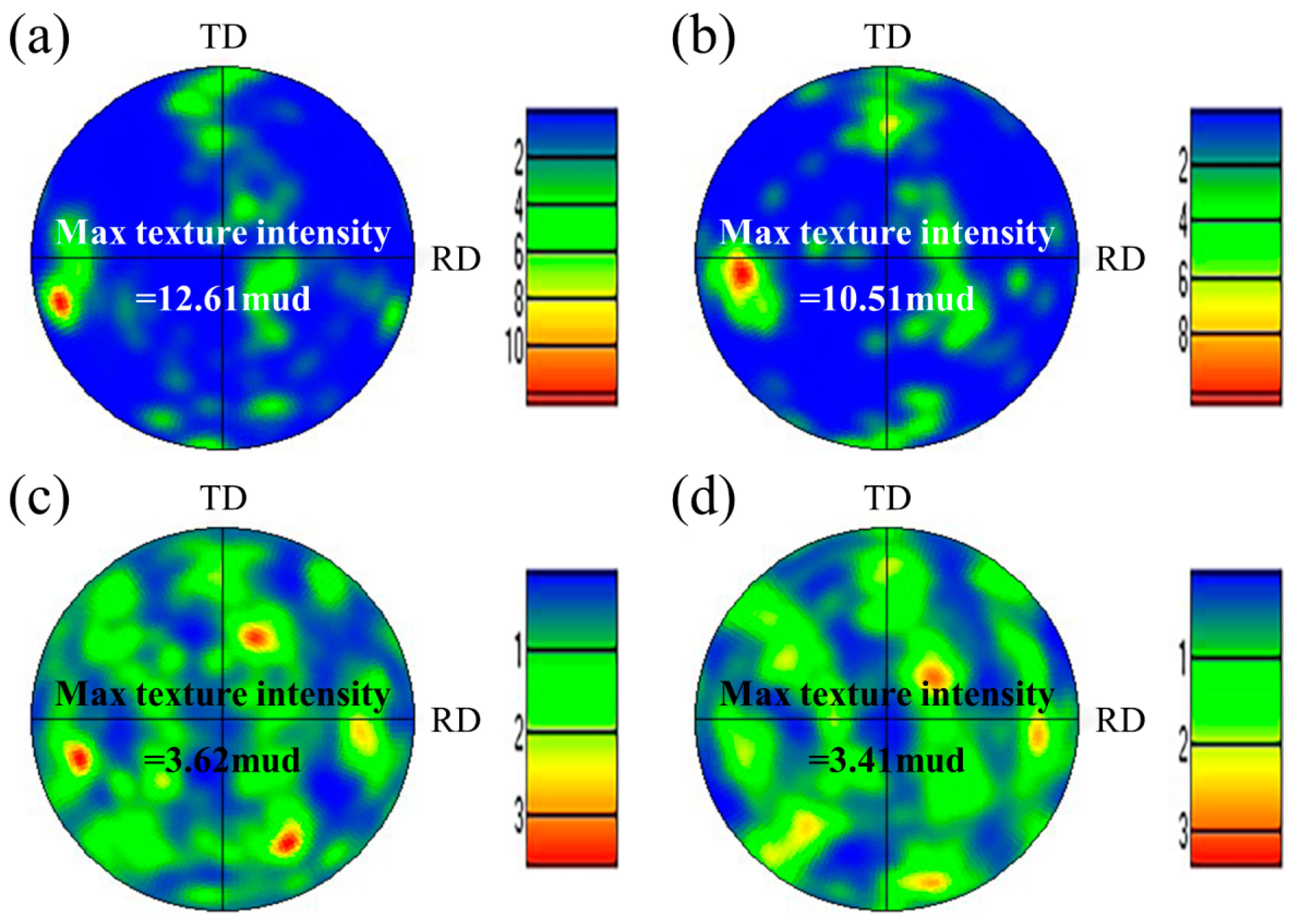

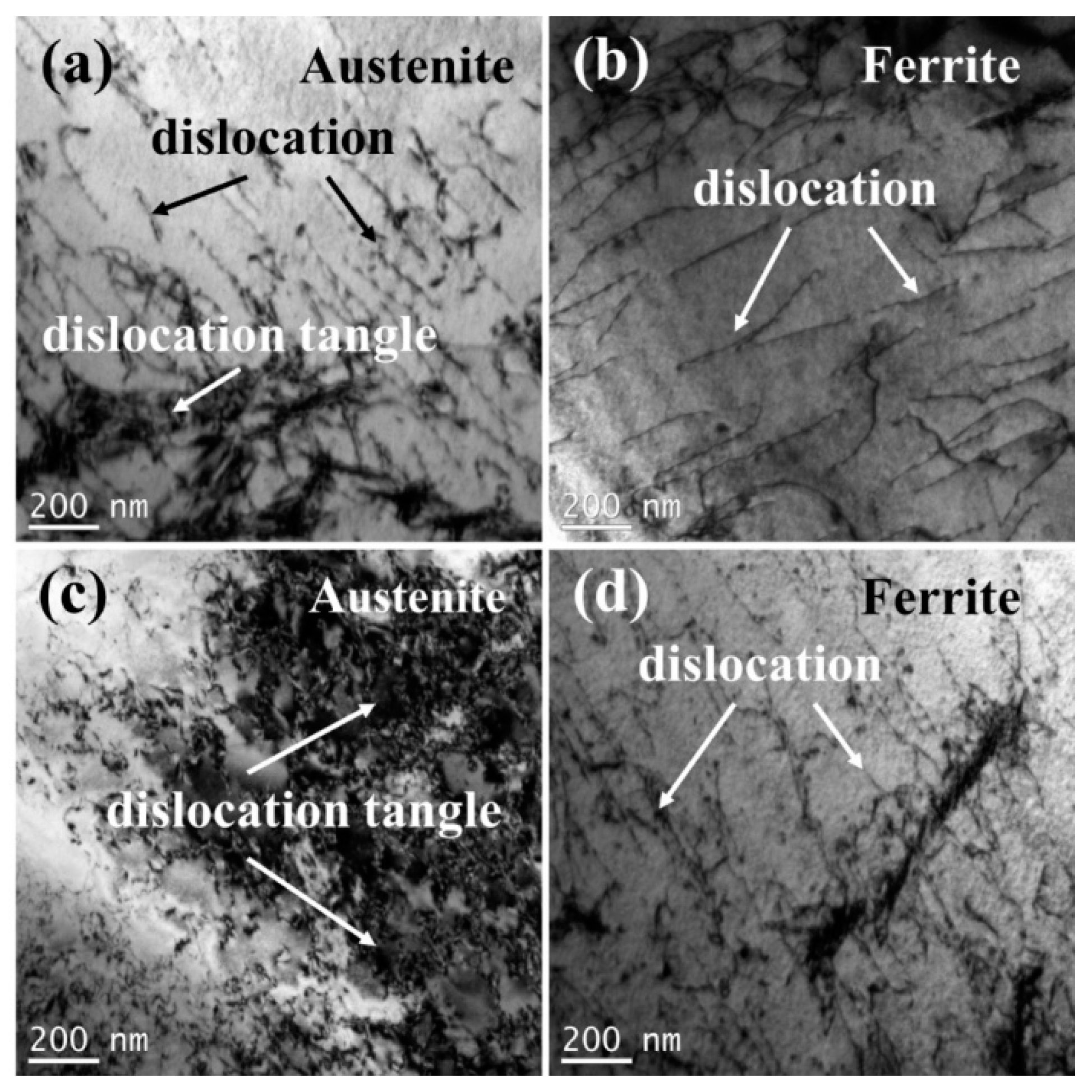
| Short Name | Full Name |
|---|---|
| SDSS | super duplex stainless steel |
| DSS | duplex stainless steel |
| WM | weld metal |
| FZ | fusion zone |
| HAZ | heat-affected zone |
| GTAW | gas tungsten arc welding |
| SMAW | shielded metal arc welding |
| GMAW | gas metal arc welding |
| FCAW | flux-cored arc welding |
| LBW | laser beam welding |
| EBW | electron beam welding |
| PAW | plasma arc welding |
| OM | optical microscope |
| XRD | X-ray diffraction |
| EBSD | electron backscatter diffraction |
| TEM | transmission electron microscopy |
| C | Si | Mn | P | S | Ni | Cr | Mo | N | Cu | Fe |
|---|---|---|---|---|---|---|---|---|---|---|
| 0.037 | 0.488 | 0.749 | 0.007 | 0.006 | 6.500 | 24.280 | 3.650 | 0.335 | 0.079 | Base |
| Welding Current (A) | Welding Speed (mm/min) | Plasma Gas Flow Rate (L/min) | Shielding Gas Flow Rate (L/min) | Back Shielding Gas Flow Rate (L/min) |
|---|---|---|---|---|
| 100 | 350 | 1.2 | 25 | 10 |
| Zone | Phase | Element (wt.%) | PREN | ||||
|---|---|---|---|---|---|---|---|
| Cr | Ni | Mo | N | ||||
| BM | _ | Ferrite | 28.366 | 5.267 | 3.846 | 0.050 | 41.858 |
| Austenite | 26.854 | 7.230 | 2.488 | 0.520 | 43.384 | ||
| Experiment A | WM | Ferrite | 27.726 | 6.119 | 3.813 | 0.050 | 41.109 |
| Austenite | 28.110 | 6.132 | 3.236 | 0.800 | 51.589 | ||
| HAZ | Ferrite | 28.078 | 5.488 | 4.368 | 0.050 | 43.292 | |
| Austenite | 27.700 | 6.271 | 2.936 | 0.882 | 51.501 | ||
| Experiment B | WM | Ferrite | 27.909 | 5.887 | 3.740 | 0.050 | 41.051 |
| Austenite | 28.163 | 6.158 | 3.281 | 0.745 | 50.910 | ||
| HAZ | Ferrite | 28.266 | 5.504 | 4.192 | 0.050 | 42.900 | |
| Austenite | 27.746 | 6.803 | 2.922 | 0.692 | 48.461 | ||
| Austenite-enriched area | Ferrite | 27.090 | 5.157 | 4.232 | 0.050 | 41.856 | |
| Austenite | 29.242 | 6.419 | 3.014 | 0.909 | 53.732 | ||
Disclaimer/Publisher’s Note: The statements, opinions and data contained in all publications are solely those of the individual author(s) and contributor(s) and not of MDPI and/or the editor(s). MDPI and/or the editor(s) disclaim responsibility for any injury to people or property resulting from any ideas, methods, instructions or products referred to in the content. |
© 2024 by the authors. Licensee MDPI, Basel, Switzerland. This article is an open access article distributed under the terms and conditions of the Creative Commons Attribution (CC BY) license (https://creativecommons.org/licenses/by/4.0/).
Share and Cite
Li, T.; Wang, K.; Lei, Y. Effects of Nitrogen on Microstructure and Properties of SDSS 2507 Weld Joints by Gas Focusing Plasma Arc Welding. Materials 2024, 17, 5375. https://doi.org/10.3390/ma17215375
Li T, Wang K, Lei Y. Effects of Nitrogen on Microstructure and Properties of SDSS 2507 Weld Joints by Gas Focusing Plasma Arc Welding. Materials. 2024; 17(21):5375. https://doi.org/10.3390/ma17215375
Chicago/Turabian StyleLi, Tianqing, Kai Wang, and Yucheng Lei. 2024. "Effects of Nitrogen on Microstructure and Properties of SDSS 2507 Weld Joints by Gas Focusing Plasma Arc Welding" Materials 17, no. 21: 5375. https://doi.org/10.3390/ma17215375
APA StyleLi, T., Wang, K., & Lei, Y. (2024). Effects of Nitrogen on Microstructure and Properties of SDSS 2507 Weld Joints by Gas Focusing Plasma Arc Welding. Materials, 17(21), 5375. https://doi.org/10.3390/ma17215375







